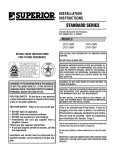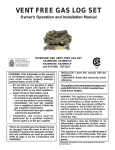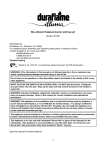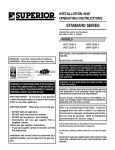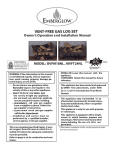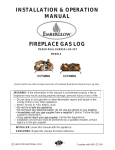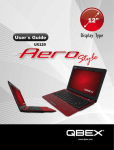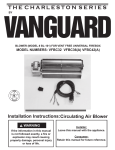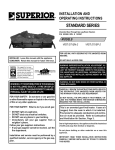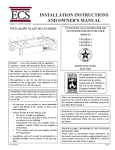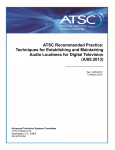Download Emberglow OVM21NG Installation Guide
Transcript
VENT FREE GAS LOG SET Owner’s Operation and Installation Manual (S,B)VFM18NG (S,B)VFM18LP (S,B)VFM24NG (S,B)VFM24LP (S,B)IVFMV18NG (S,B)IVFMV18LP (S,B)IVFMV24NG (S,B)IVFMV24LP Also Design-Certified As Vented Decorative Appliances ANSI Z21.11.2 - 2011 Unvented Heaters ANSI Z21.60 - 2012 Vented Decorative Appliances WARNING: If the information in this manual is not followed exactly, a fire or explosion may result causing property damage, personal injury, or loss of life. — Do not store or use gasoline or other flammable vapors and liquids in the vicinity of this or any other appliance. — WHAT TO DO IF YOU SMELL GAS • Do not try to light any appliance. • Do not touch any electrical switch; do not use any phone in your building. • Immediately call your gas supplier from a neighbor’s phone. Follow the gas supplier’s instructions. • If you cannot reach your gas supplier, call the fire department. — Installation and service must be performed by a qualified installer, service agency, or the gas supplier. This is an unvented gas-fired heater. It uses air (oxygen) from the room in which it is installed. Provisions for adequate combustion and ventilation air must be provided. Refer to page 4, Air for Combustion and Ventilation. INSTALLER: Leave this manual with the appliance. CONSUMER: Retain this manual for future reference. This appliance has been tested and approved under ANSI Z21.11.2–2011 Unvented GasFired Room Heaters. WARNING: This appliance is for installation only in a solid fuel burning masonry or UL127 factory-built fireplace or listed ventless firebox enclosure. It has been design certified for these installations. EXCEPTION: DO NOT install this appliance in a factory-built fireplace that includes instruction stating it has not been tested or should not be used with unvented gas logs. This appliance may be installed in an aftermarket,* permanently located, manufactured (mobile) home, where not prohibited by local codes. This appliance is only for use with the type of gas indicated on the rating plate. This appliance is not convertible for use with other gases. * Aftermarket: Completion of sale, not for purpose of resale, from the manufacturer TABLE OF CONTENTS Safety Information ........................................................ 2 Local Codes .................................................................. 3 Unpacking ..................................................................... 4 Product Features............................................................ 4 Qualified Installation Agency ....................................... 4 Air For Combustion and Ventilation ............................ 4 Installation..................................................................... 7 Operating Log Set ....................................................... 13 Inspecting Burners ...................................................... 18 Cleaning and Maintenance.......................................... 18 Troubleshooting .......................................................... 19 Specifications .............................................................. 22 Parts List and Illustrated Parts Breakdown ................. 24 Warranty Information .................................. Back Cover SAFETY INFORMATION You must operate this heater with the fireplace screen in place. Make sure the fireplace screen is in place before funning this appliance. Unless other provisions are made for combustion air, the screens shall have an opening or openings for introduction of combustion air into the fireplace If this appliance is installed in a fireplace that has glass doors, the doors must be left open when the appliance is in use. WARNING: Improper installation, adjustment, alteration, service, or maintenance can cause injury or property damage. Refer to this manual for correct installation and operational procedures. For assistance or additional information consult a qualified installer, service agency, or the gas supplier. WARNING:This product contains and/or generates chemicals known to the state of California to cause cancer or birth defects or other reproductive harm. 2 DANGER: Carbon monoxide poisoning may lead to death! Carbon Monoxide Poisoning: Early signs of carbon monoxide poisoning resemble the flu, with headaches, dizziness, and/or nausea. If you have these signs, heater may not be working properly. Get fresh air at once! Have heater serviced. Some people–pregnant women, persons with heart or lung disease, anemia, those under the influence of alcohol, those at high altitudes–are more affected by carbon monoxide than others. Propane/LP Gas: Propane/LP gas is odorless. An odormaking agent is added to the gas. The odor helps you detect a gas leak. However, the odor added to the gas can fade. Gas may be present even though no odor exists. Make certain you read and understand all warnings. Keep this manual for reference. It is your guide to safe and proper operation of this appliance. WARNING: Any change to this heater or its controls can be dangerous. WARNING: Do not use a blower insert, heat exchanger insert, or other accessory not approved for use with this appliance. WARNING: Do not allow fans to blow directly into the appliance. Avoid any drafts that alter burner flame patterns. Ceiling fans can create drafts that alter burner flame patterns. Altered burner patterns can cause sooting. Due to high temperatures, the appliance should be located out of traffic and away from furniture and draperies. Do not place clothing or other flammable material on or near the appliance. Never place any objects on the heater. Fireplace front and screen become very hot when running appliance. Keep children and adults away from hot surfaces to avoid burns or clothing ignition. Logs will remain hot for a time after shutdown. Allow surfaces to cool before touching. Carefully supervise young children when they are in the room with fireplace. SAFETY INFORMATION CONTINUED Keep the appliance area clear and free from combustible materials, gasoline, and other flammable vapors and liquids. 1. This appliance is only for use with the type of gas indicated on the rating plate. This appliance is not convertible for use with other gases. 2. Do not place propane/LP supply tank(s) inside any structure. Locate propane/LP supply tank(s) outdoors (propane/LP units only). 3. If you smell gas • shut off gas supply • do not try to light any appliance • do not touch any electrical switch; do not use any phone in your building • immediately call your gas supplier from a neighbor’s phone. Follow the gas supplier’s instructions • if you cannot reach your gas supplier, call the department 4. This appliance shall not be installed in a bedroom or bathroom. 5. Do not use this appliance as a wood-burning fireplace. Use only the logs provided with the appliance. 6. Do not add extra logs or ornaments such as pine cones, vermiculite or rock wool. Using these added items can cause sooting and poor combustion. Do not add lava rock around base. Rock and debris could fall into the control area of heater. 7. This appliance is designed to be smokeless. If logs ever appear to smoke, turn off appliance and call a qualified service person. Note: During initial operation, slight smoking could occur due to log curing and fireplace burning manufacturing residues. 8. To prevent the creation of soot, follow the instructions in Cleaning and Maintenance section. Keep the appliance area clear and free from combustible materials, gasoline and other flammable vapors and liquids. 9. Before using furniture polish, wax, carpet cleaner, or similar products, turn heater off. If heated, the vapors from these products may create a white powder residue within burner box or on adjacent walls or furniture. 10. This appliance needs fresh air ventilation to run properly. This appliance has an Oxygen Depletion Sensing (ODS) safety shutoff system. The ODS shuts down the fireplace if not enough fresh air is available. See Air for Combustion and Ventilation, pages 4 through 6. If appliance keeps shutting off, see Troubleshooting, pages 17 through 20. 11. Do not run appliance • where flammable liquids or vapors are used or stored • under dusty conditions 12. Do not use this appliance to cook food or burn paper or other objects. 13. Never place any objects in the heater or on logs. 14. Do not use appliance if any part has been exposed to or under water. Immediately call a qualified service technician to inspect the appliance and to replace any part of the control system and any gas control which has been under water. 15. Turn appliance off and let cool before servicing. Only a qualified service person should service and repair appliance. 16. Operating appliance above elevations of 4,500 feet could cause pilot outage. 17. To prevent performance problems, do not use propane/ LP fuel tanks of less than 100 lbs. capacity. 18. Provide adequate clearances around air openings. LOCAL CODES Install and use appliance with care. Follow all local codes. In the absence of local codes, use the latest edition of The National Fuel Gas Code ANSI Z223.1/NFPA 54*. *Available from: American National Standards Institute, Inc. 1430 Broadway New York, NY 10018 National Fire Protection Association, Inc. Batterymarch Park Quincy, MA 02269 State of Massachusetts: The installation must be made by a licensed plumber or gas fitter in the Commonwealth of Massachusetts. Sellers of unvented propane or natural gas-fired supplemental room heaters shall provide to each purchaser a copy of 527 CMR 30 upon sale of the unit. Vent-free gas products are prohibited for bedroom and bathroom installation in the Commonwealth of Massachusetts. 3 UNPACKING 1. Remove the carton and log wrap. 2. Remove all protective packaging applied to heater for shipment. 3. Make sure your logset includes one hardware packet. 4. Check heater for any shipping damage. If h eater is damaged, call SHM International at (800) 229-5647 for replacement parts before returning to dealer. PRODUCT FEATURES SAFETY PILOT This heater has a pilot with an Oxygen Depletion Sensing (ODS) safety shutoff system. The ODS/pilot is a required feature for vent-free room heaters. The ODS/pilot shuts off the heater if there is not enough fresh air. PIEZO IGNITION SYSTEM This heater has a piezo ignitor. This system requires no matches, batteries or other sources to light heater. THERMOSTATIC HEAT CONTROL Thermostat-controlled models have a thermostat sensing bulb and a control valve. The thermostat will automatically modulate the heat output to maintain a consistent room temperature. This results in greater heater comfort. This can also result in lower gas bills. QUALIFIED INSTALLATION AGENCY Installation and replacement of gas piping, gas utilization equipment or accessories and repair and servicing of equipment shall be performed only by a qualified agency. The term “qualified agency” means any individual, firm, corporation, or company that either in person or througha representative is engaged in and is responsible for: AIR FOR COMBUSTION AND VENTILATION WARNING: This heater shall not be installed in a room or space unless the required volume of indoor combustion air is provided by the method described in the National Fuel Gas Code, ANSI Z223.1/ NFPA 54, the International Fuel Gas Code, or applicable local codes. Read the following instructions to insure proper fresh air for this and other fuelburning appliances in your home. Today’s homes are built more energy efficient than ever.New materials, increased insulation, and new construction methods help reduce heat loss in homes. Home owners weather strip and caulk around windows and doors to keep the cold air out and the warm air in. During heating months, home owners want their homes as airtight as possible. While it is good to make your home energy efficient, your home needs to breathe. Fresh air must enter your home. All fuel-burning appliances need fresh air for proper combustion and ventilation. Exhaust fans, fireplaces, clothes dryers, and fuel burning appliances draw air from the house to operate. You must provide adequate fresh air for these appliances. This will insure proper venting of vented fuel-burning appliances. PROVIDING ADEQUATE VENTILATION The following are excerpts from National Fuel Gas Code ANSI Z223.1/NFPA 54,Section 5.3, Air for Combustion and Ventilation. All spaces in homes fall into one of the following ventilation classifications: A. Installation, testing or replacements of gas piping or 1. Unusually Tight Construction B. Connection, installation, testing, repair or servicing of equipment that is experienced in such work; that is familiar with all precautions required; and that has complied with all requirement of the authority having jurisdiction. 2. Unconfined Space The information on pages 4 through 6 will help you classify your space and provide adequate ventilation. This heater shall not be installed in a confined space or unusually tight construction unless provisions are provided for adequate combustion and ventilation air. 4 Unusually Tight Construction Ventilation Air From Outdoors The air that leaks around doors and windows may provide enough fresh air for combustion and ventilation. However, in buildings of unusually tight construction, you must provide additional fresh air. Provide extra fresh air by using ventilation grills or ducts. You must provide two permanent openings: one within 12" of the ceiling and one within 12" of the floor. Connect these items directly to the outdoors or spaces open to the outdoors. These spaces include attics and crawl spaces. Follow the National Fuel Gas Code ANSI Z223.1/NFPA 54, Section 5.3, Air for Combustion and Ventilation for required size of ventilation grills or ducts. Unusually tight construction is defined as construction where: a. walls and ceilings exposed to the outside atmosphere have a continuous water vapor retarder with a rating of one perm (6 x 10-11 kg per pa-sec-m2) or less with openings gasketed or sealed and b. weather stripping has been added on openable windows and doors and c. caulking or sealants are applied to areas such as joints around window and door frames, between sole plates and floors, between wallceiling joints, between wall panels, at penetra tions for plumbing, electrical, and gas lines, and at other openings. If your home meets all of the three criteria above, you must provide additional fresh air. See Ventilation Air From Outdoors, page 5. If your home does not meet all of the three criteria above, proceed to Determining Fresh-Air Flow for Appliance Location, page 6. VENTILATION AIR Ventilation Air From Inside Building This fresh air would come from an adjoining unconfined space. When ventilating to an adjoining unconfined space, you must provide two permanent openings: one within 12" of the ceiling and one within 12" of the floor on the wall connecting the two spaces (see Figure 1). You can also remove door into adjoining room (see Figure 1). Follow the National Fuel Gas Code ANSI Z223.1/NFPA 54, Section 5.3, Air for Combustion and Ventilationfor required size of ventilation grills or ducts. 12" Ventilation Grills Into Adjoining Room, Option 1 Ventilation Grills Into Adjoining Room, Option 2 Or Remove Door into Adjoining Room, Option 3 12" IMPORTANT: Do not provide openings for inlet or outlet air into attic if attic has a thermostat-controlled power vent. Heated air entering the attic will activate the power vent. Outlet Air Outlet Air Ventilated Attic To Attic To Crawl Space Inlet Air Inlet Air Ventilated Crawl Space Figure 2 - Ventilation Air from Outdoors DETERMINING FRESH-AIR FLOW FOR APPLIANCE LOCATION Determining if You Have a Confined or Unconfined Space Use this work sheet to determine if you have a confined or unconfined space. Space: Includes the room in which you will install appliance plus any adjoining rooms with doorless passageways or ventilation grills between the rooms. 1. Determine the volume of the space (length x width x height). Length x Width x Height = cu. ft. (volume of space) Example: Space size 22 ft. (length) x 18 ft. (width) x 8 ft. (ceiling height) = 3168 cu. ft. (volume of space) If additional ventilation to adjoining room is supplied with grills or openings, add the volume of these rooms to the total volume of the space. 2. Multiply the space volume by 20 to determine the maximum Btu/Hr the space can support. _______ (volume of space) x 20 = (Maximum Btu/Hr the space can support) Figure 1 - Ventilation Air from Inside Building Example: 3168 cu. ft. (volume of space) x 20 = 63,360 (maximum Btu/Hr the space can support) 5 AIR FOR COMBUSTION AND VENTILATION CONTINUED 3. Add the Btu/Hr of all fuel burning space. Vent-free log set _______________ Gas water heater* ______________ Gas furnace___________________ Vented gas heater ______________ Gas fireplace logs ______________ Other gas appliances* + ________ Total = ________ appliances in the Btu/Hr Btu/Hr Btu/Hr Btu/Hr Btu/Hr Btu/Hr Btu/Hr * Do not include direct-vent gas appliances. Direct-vent draws combustion air from the outdoors and vents to the outdoors. Example: 39,000 Btu/Hr Vent-free log set ______________ 40,000 Btu/Hr Gas water heater* _____________ 79,000 Btu/Hr Total = ________ 4. Compare the maximum Btu/Hr the space can support with the actual amount of Btu/Hr used. ____ Btu/Hr (max. the space can support) ____ Btu/Hr (actual amt. of Btu/Hr used) Example: 63,300 Btu/Hr (maximum the space can support) WARNING: If the area in which the heater may be operated does not meet the required volume for indoor combustion air, combustion and ventilation air shall be provided by one of the methods described in the National Fuel Gas Code, ANSI Z223.1/ NFPA 54, the International Fuel Gas Code, or applicable local codes. Note: When used as a vented heater, appliance must be installed only in a solid-fuel burning fireplace with a working flue and constructed of noncombustible material. VENTED OPERATION You may also use this heater as a vented product. There are. three reasons for operating your heater in the vented mode. 1. 2. The fireplace does not meet the clearance to combustibles requirements for vent-free operation. State or local codes do not permit vent-free operation. 3. You prefer vented operation. If reasons number 1 or 2 above apply to you, you must permanently open chimney flue damper. You must install the damper clamp. This will insure vented operation (see Figu r e 10). The damper clamp will keep damper open. See chart below for minimum permanent flue opening you must provide. Attach damper clamp so the minimum permanentflue opening will be maintained at all times. Area of Various Standard Round Flues 73,000 Btu/Hr (actual amount of Btu/Hr used) The space in the above example is a confined space because the actual Btu/Hr used is more than the maximum Btu/Hr the space can support. You must provide additional fresh air. Your options are as follows: Diameter (ins.) Area (sq. ins.) 5" 6" 7" 8" 20 sq. inches 29 sq. inches 39 sq. inches 51 sq. inches A. Rework work sheet, adding the space of an adjoining room . If the extra space provides an unconfined space, remove door to adjoining room or add ventilation grills between rooms. See Ventilation Air from Inside Building,page 5. Chimney Minimum Permanent Height (ft.) Flue Opening (sq. ins.) 6' to 15' 15' to 30' 39 sq. inches 29 sq. inches B. Vent room directly to the outdoors. See Ventilation Air from Outdoors, page 5. C. Install a lower Btu/Hr appliance, if lower Btu/Hr size makes room unconfined. If the actual Btu/Hr used is less than the maximum Btu/Hr the space can support, the space is an unconfined space. You will need no additional fresh air ventilation. Damper Clamp Damper Follow instructions Installing Damper Clamp on page 8 for location of damper in the fireplace. The National Fuel Gas Code, ANS I Z223.1/NFPA 54 defines a confined space as a space space whose volume is less than 50 ft3 per 1000btu/hr (4.8 m3 per kw) of the aggregate input of all appliances installed in that space. Rooms communicating directly with the space in which the appliances are installed, through openings not furnished with doors are considered a part of the unconfined space. 6 INSTALLATION WARNING: Before installing in a solidfuel-burning fireplace, the chimney flue and firebox must be cleaned of soot, creosote, ashes, and loose paint by a qualified chimney cleaner. NOTICE: This appliance is intended for supplemental heating. Use this heater along with your primary heating system. Do not install this heater as your primary heat source. If you have a central heating system, you may run system’s circulating blower while using heater. This will help circulate the heat throughout the house. In the event of a power outage, you can use this heater as your primary heat source. WARNING: A qualified service person must install appliance. Follow all local codes. • • • • • WARNING: Never install the appliance in a recreational vehicle where curtains, furniture, clothing, or other flammable objects are less than 36 inches (91.5 cm) from the front, top, or sides of the appliance in a wood-burning stove areas in high in windy or drafty areas WARNING: Never install in a bedroom or bathroom. Any heating product with a Btu/Hr rating over 10,000 cannot be used in a bedroom. Any heating product with a Btu/Hr rating over 6,000 cannot be used in a bathroom. CAUTION: This appliance creates warm air currents. These currents move heat to wall surfaces next to appliance. Installing appliance next to vinyl or cloth wall coverings or operating appliance where impurities (such as tobacco smoke, aromatic candles, cleaning fluids, oil or kerosene lamps, etc.) in the air exist, may discolor walls. IMPORTANT: Vent-free heaters add moisture to the air. Although this is beneficial, installing appliance in rooms without enough ventilation air may cause mildew to form from too much moisture. See Air for Combustion and CHECK GAS TYPE Use the correct gas type (natural or propane/LP) for your appliance. If your gas supply is not correct or if you do not know your gas type, do not install appliance. INSTALLATION ITEMS NEEDED Before installing appliance, make sure you have the items listed below. • external regulator for propane/LP unit only (supplied by installer) • piping (check local codes) • sealant (resistant to propane/LP gas) • equipment shutoff valve * • test gauge connection * • ground joint union • sediment trap (optional) • tee joint • pipe wrench • approved flexible gas line (not provided), or provided gas connector (if allowed by local codes) * A CSA/AGA design-certified equipment shutoff valve with 1/8" NPT tap is an acceptable alternative to test gauge connection. Purchase the optional CSA/AGA design-certified equipment shutoff valve from your dealer. For propane/LP units, the installer must supply an external regulator. The external regulator will reduce incoming gas pressure. You must reduce incoming gas pressure to between 11 and 14 inches of water. If you do not reduce incoming gas pressure, heater regulator damage could occur. LOG SET PLACEMENT Place the log set in the center of your fireplace or firebox. CLEARANCES (Vent-Free Operation Only) WARNING: Maintain the minimum clearances. If you can, provide greater clearances from floor, ceiling, and adjoining wall. Minimum Fireplace Clearance To Combustible Materials Log Size Side Wall 18", 21", 24" Ceiling 15.5" 42" LOG SIZING REQUIREMENTS Minimum Firebox Size Log Front Rear* Size Height Depth Width Width 18" 21", 24" 18" 18" 12" 15" 22" 28" 18" 22" *Measured at 14" Depth Ventilation, page 4. 7 INSTALLATION CONNECTING TO GAS SUPPLY CONTINUED INSTALLATION CLEARANCES WARNING: Maintain the minimum clearances. Mantel Clearances for Installation If placing mantel above heater, you must meet the minimum clearance between the mantel shelf and the top of the firebox opening. NOTICE: Surface temperatures of adjacent walls and mantels become hot during operation. Walls and mantels above the firebox may become hot to the touch. If installed properly, these temperatures meet the requirement of the national product standard. Follow all minimum clearances shown in this manual. WARNING: This appliance requires a 5/8” UNF (Unified National Fine Thread) and 1/2" NPT (National Pipe Thread) inlet connection and the gas connection tube provided. WARNING: A qualified service person must connect log set to gas supply. Follow all local codes. WARNING: Never connect natural gas log set to private (non-utility) gas wells. This gas is commonly known as wellhead gas. IMPORTANT: For natural gas, check gas line pressure before connecting heater to gas line. Gas line pressure must be no greater than 10.5” of water. If gas line pressure is higher, heater regulator damage could occur. For propane/LP gas, the installer must supply an external regulator. The external regulator will reduce incoming gas pressure. You must reduce incoming gas pressure to between 11” and 14” of water. If you do not reduce incoming gas pressure, heater regulator damage could occur. Install the external regulator with the vent pointing down as shown in Figure 4. Pointing the vent down protects it from freezing rain or sleet. 13” 8” CAUTION: Never connect propane/LP log set directly to the propane/LP supply. This appliance requires an external regulator (not supplied). Install the external regulator between the appliance and propane/ LP supply. External Regulator Propane/LP Supply Tank Figure 3 - Minimum Mantel Clearances for Installation Damper Clamp Vent Pointing Down Damper Damper Figure 4 - External Regulator with Vent Pointing Down Masonry Fireplace Manufactured Fireplace INSTALLING DAMPER CLAMP ACCESSORY FOR VENTED OPERATION 8 CAUTION: Use only new, black iron or steel pipe. Internally-tinned copper tubing may be used in certain areas. Check your local codes. Use pipe of 1/2" diameter or greater to allow proper gas volume to appliance. If pipe is too small, undue loss of pressure will occur. Shutoff Valve Installation must include an equipment shutoff valve, union, and plugged 1/8” NPT tap. Locate NPT tap within reach for test gauge hook up. NPT tap must be upstream from appliance. IMPORTANT: Install equipment shutoff valve in an accessible location. The equipment shutoff valve is for turning on or shutting off the gas to the appliance. Check your building codes for any special requirements for locating equipment shutoff valve to fireplaces. Apply pipe joint sealant lightly to male NPT threads. This will prevent excess sealant from going into pipe. Excess sealant in pipe could result in clogged fireplace valves. Never use sealant on flare threads. CSA/AGA DesignCertified Equipment Shutoff Valve With 1/8" NPT Tap* Approved Gas Line 3" Minimum Pipe Cap Tee Nipple Joint Propane/LP From External Regulator (11” W.C.** to 14” W.C. Pressure) Natural Gas From Gas Meter (7” W.C.** to 10.5” W.C. Pressure) Sediment Trap Figure 5 - Gas Connection * Purchase the optional CSA/AGA design-certified equipment shutoff valve from your dealer. ** Minimum inlet pressure for purpose of input adjustment. CAUTION: Use pipe joint sealant that is resistant to liquid petroleum (LP) gas. We recommend that you install a sediment trap in supply line as shown in Figure 5. Locate sediment trap where it is within reach for cleaning. Install in piping system between fuel supply and appliance. Locate sediment trap where trapped matter is not likely to freeze. A sediment trap traps moisture and contaminants. This keeps them from going into appliance gas controls. If sediment trap is not installed or is installed wrong, appliance may not run properly. CHECKING GAS CONNECTIONS WARNING: Test all gas piping and connections, internal and external to unit, for leaks after installing or servicing. Correct all leaks at once. WARNING: Never use an open flame to check for a leak. Apply a mixture of liquid soap and water to all joints. Bubbles forming show a leak. Correct all leaks at once. Pressure Testing Gas Supply Piping System Test Pressures In Excess Of 1/2 PSI (3.5 kPa) 1. Disconnect appliance with its main gas valve (control valve) and equipment shutoff valve from gas supply piping system. Pressures in excess of 1/2 psi will damage appliance gas regulator. 2. Cap off open end of gas pipe where equipment shutoff valve was connected. 3. Pressurize supply piping system by either opening propane/LP supply tank valve for propane/LP gas or opening main gas valve located on or near gas meter of natural gas or using compressed air. 4. Check all joints of gas supply piping system. Apply noncorrosive leak detection fluid to all joints. Bubbles forming show a leak. 5. Correct all leaks at once. 6. Reconnect appliance and equipment shutoff valve to gas supply. Check reconnected fittings for leaks. 9 INSTALLATION CONTINUED Test Pressures Equal To or Less Than 1/2 PSIG (3.5 kPa) 1. Close equipment shutoff valve (see Figure 6). 2. Pressurize supply piping system by either opening propane/LP supply tank valve for propane/LP gas or opening main gas valve located on or near gas meter of natural gas or using compressed air. 3. Check all joints from gas meter to equipment shutoff valve for natural gas or propane/LP supply to equipment shutoff valve for propane/LP. Apply noncorrosive leak detection fluid to all joints. Bubbles forming show a leak. 4. Correct all leaks at once. OPTIONAL REMOTE CONTROL SET INSTALLATION AND SET-UP Remote control purchased seperatly. - + - + Install four (4) "AA" batteries into the remote receiver box as shown on the left. Install three (3) "AAA" batteries into the remote control as shown on the left. Open ON POSITION Equipment Shutoff Valve OFF POSITION Closed Figure 6 - Equipment Shutoff Valve MANUAL SHUT-OFF VALVE GRH/OV 020 ON/OFF Key Transmission light PRESSURE TESTING APPLIANCE GAS CONNECTIONS 1. Open equipment shutoff valve (see Figure 14). 2. For natural gas, open main gas valve located on or near gas meter. For propane/LP gas, open propane/LP supply tank valve. 3. Make sure control knob of fireplace is in the OFF position. 4. Check all joints from equipment shutoff valve to gas control valve. Apply noncorrosive leak detection fluid to all joints. Bubbles forming show a leak. 5. Correct all leaks at once. 6. Light fireplace (see Operating Log Set, page 13). Check all other internal joints for leaks. 7. Turn off fireplace (see To Turn Off Gas To Log Set, page 14). 10 Side Slider COMMUNICATION BETWEEN THE REMOTE CONTROL TRANSMITTER AND THE RECEIVER To program the transmitter to the receiver , move the three positions slider of the receiver in the REMOTE position and depress the ON/OFF key of the transmitter. The System has an automatic learning mode that allows the receiver to mate with a new trans mitter in the event the trans mitter must be replaced. As soon as the receiver module receives the firstcorrectcommand from any remote control it captures the new address and then "beeps"3 times to confirm the syncronization and command execution. Log Placement CVO(18,24,30) MV(18,24)VFM, And OVM21 13 14 15 16 17 IMPORTANT ! Check and make sure the logs are clear of The burner flame. Flames touching the logs can produce soo ng! 18 19 19 20 21 22 20 (Main gas tube may be carefully bent into needed shape) 20 Tube, Main Gas Supply WIP-120-90414 WIP-120-90414 WIP-120-90414 23 13 (Gas supply tube may be carefully bent into needed shape) 24 SERVICE INFORMATION REPLACEMENT PARTS SERVICE HINTS Note: Use only original replacement parts. This will protect your warranty coverage for parts replaced under warranty. When gas pressure is too low: • pilot will not stay lit • heater will not produce the specified heat • propane/LP gs supply may be low Parts Under Warranty Contact authorized dealers of this product. If they can’t supply original replacement part(s), call SHM International’s Technical Service Department at (800) 229-5647. When calling SHM International, have ready: • your name • your address • model and serial numbers of your heater • how heater was malfunctioning • type of gas used (propane/LP or natural gas) • purchase date Usually, we will ask you to return the part to the factory. Parts Not Under Warranty Contact authorized dealers of this product. If they can’t supply original replacement part(s), call SHM International at (800) 229-5647 for referral information. When calling SHM International, have ready: • model number of your heater • the replacement part number (see Page 23-24) You may feel your gas pressure is too low. If so, contact your local natural or propane/LP gas supplier. Note: Use only original replacement parts. This will protect your warranty coverage for parts replaced under warranty. TECHNICAL SERVICE You may have further questions about installation, operation or troubleshooting. If so, contact SHM International’s Technical Service Department at (800) 229-5647. When calling please have your model and serial numbers of your heater ready. You can also visit SHM International’s Technical Service web site at www.sureheat.com. SPECIFICATIONS Model (S,B) VFM18NG VFM18LP VFM21,24NG VFM21,24LP VFM27,30NG VFM27,30LP Propane/LP Natural Gas Propane/LP Natural Gas Propane/LP Natural Gas 34,000 BTU/Hr 34,000 BTU/Hr 39,000 BTU/Hr 39,000 BTU/Hr 39,000 BTU/Hr 39,000 BTU/Hr Input Max. 22,000 BTU/Hr 22,000 BTU/Hr 22,000 BTU/Hr 22,000 BTU/Hr 22,000 BTU/Hr 22,000 BTU/Hr Input Min. Manifold Pressure 8.0” W.C. 3.5” W.C. 3.5” W.C. 8.0” W.C. 3.5” W.C. 8.0” W.C. 14.0” W.C. 14.0” W.C. Inlet Pressure Max. 10.5” W.C. 10.5” W.C. 14.0” W.C. 10.5” W.C. 11.0” W.C. 11.0” W.C. 7.0” W.C. 7.0” W.C. Inlet Pressure Min.* 7.0” W.C. 11.0” W.C. 18” H X 22” W X 12” D 18” H X 28” W X 15” D Min. Firebox Size 18” H X 34” W X 15” D Gas Type Model (S,B) IVFMV18NG IVFMV18LP IVFMV21,24NG IVFMV21,24LP IVFMV27,30NG IVFMV27,30LP Propane/LP Natural Gas Propane/LP Natural Gas Propane/LP Natural Gas 34,000 BTU/Hr 34,000 BTU/Hr 39,000 BTU/Hr 39,000 BTU/Hr 39,000 BTU/Hr 39,000 BTU/Hr Input Max. 22,000 BTU/Hr 22,000 BTU/Hr 22,000 BTU/Hr 22,000 BTU/Hr 22,000 BTU/Hr 22,000 BTU/Hr Input Min. Manifold Pressure 8.0” W.C. 3.5” W.C. 3.5” W.C. 8.0” W.C. 3.5” W.C. 8.0” W.C. 14.0” W.C. 14.0” W.C. Inlet Pressure Max. 10.5” W.C. 10.5” W.C. 14.0” W.C. 10.5” W.C. 11.0” W.C. 11.0” W.C. 7.0” W.C. 7.0” W.C. Inlet Pressure Min.* 7.0” W.C. 11.0” W.C. 18” H X 22” W X 12” D 18” H X 28” W X 15” D Min. Firebox Size 18” H X 34” W X 15” D Gas Type *For purpose of input adjustment 25 WARRANTY INFORMATION KEEP THIS WARRANTY Model ______________________________ Serial No. ___________________________ Date Purchased _____________________ Always specify model and serial numbers when communicating with the factory. LIMITED WARRANTY SHM International Corp. warrants the components of this appliance to be free from defects in material and workmanship for one (1) year from the date of purchase. SHM International Corp. at its option, will repair or replace this product or any component of the product found to be defective during the warranty period. Replacement will be made with a new manufactured product or component. If the product is no longer available, replacement may be made with a similar product of equal value. This warranty does not include transportation or shipping costs of any kind. This your exclusive warranty. This warranty is valid for the original retail purchaser from the date of initial retail purchase and is not transferable. Keep the original sales receipt. Proof of purchase is required to obtain warranty parts. This warranty does not cover normal wear of parts such as scratches and dents of the components or damage resulting from any of the following: • negligent use or misuse of the product, including exposing the product to chemicals or cleaning products not approved by SHM International Corp. • corrosion, rust or discoloring of any kind instructions and applicable building codes, including heating the • use or installation contrary to product to temperatures above its rated specifications which can cause considerable warping • disassembly, including removal of the product from a built-in installation • damage resulting from accident, alteration, misuse, abuse, hostile environments, or improper installation • repair or alteration • acts of God, such as hurricanes, and tornadoes • gas cylinders, propane tanks or other fuel delivery systems, including connections to a household fuel supply • usage other than single-family household use such as commercial or industrial use • minor warping or discoloration of parts, which is normal and not a defect under this warranty DO NOT RETURN THIS PRODUCT TO THE PLACE OF PURCHASE If the appliance does not operate properly, first thoroughly carry out the instructions provided with the unit to ensure that the appliance is installed correctly and check the troubleshooting section in the use and care manual. We recommend you return the warranty registration card so that you can be contacted when any questions of safety arise that could affect you. The return of the warranty registration card is not a condition for warranty coverage. Because of continuing product improvement, these specifications are subject to change without notice. If you have other questions or need replacement parts, contact our Customer Service Hotline at (800) 229-5647 or visit our website at www.sureheat.com. SHM International Corp. 3140 Moon Station Road, Kennesaw, GA 30144 RTP2011A RMH-130-OML Rev. 1.4 06/2014






























